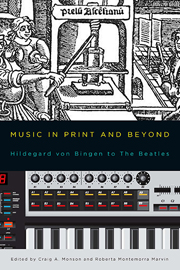Book contents
- Frontmatter
- Dedication
- Contents
- Acknowledgments
- Introduction
- 1 Robert Granjon and Music during the Golden Age of Typography
- 2 Publishing Music Theory in Early Cinquecento Venice and Bologna: Friends and Foes
- 3 Preaching to the Choir: Arts of Persuasion in the Converts of Italy
- 4 Music Distribution in London during Handel's Lifetime: Manuscript Copies versus Prints
- 5 Beethoven's Miniatures
- 6 “The Beautiful and the Ugly”: Travel Literature, Racial Theory, and a Schumann Song
- 7 Verdi's “Music of the Future”
- 8 The Suspended Voice of Amália Rodrigues
- 9 More than Mostly Mozart: Teddy Wilson's “China Boy”
- 10 Wanted Dead and Alive: Historical Performance Practice and Electro-Acoustic Music from IRCAM to Abbey Road
- 11 Lowinsky's Secrets
- 12 The Unknown Hildegard: Editing, Performance, and Reception (An Ordo Virtutum in Five Acts)
- List of Contributors
- Index
4 - Music Distribution in London during Handel's Lifetime: Manuscript Copies versus Prints
Published online by Cambridge University Press: 05 March 2014
- Frontmatter
- Dedication
- Contents
- Acknowledgments
- Introduction
- 1 Robert Granjon and Music during the Golden Age of Typography
- 2 Publishing Music Theory in Early Cinquecento Venice and Bologna: Friends and Foes
- 3 Preaching to the Choir: Arts of Persuasion in the Converts of Italy
- 4 Music Distribution in London during Handel's Lifetime: Manuscript Copies versus Prints
- 5 Beethoven's Miniatures
- 6 “The Beautiful and the Ugly”: Travel Literature, Racial Theory, and a Schumann Song
- 7 Verdi's “Music of the Future”
- 8 The Suspended Voice of Amália Rodrigues
- 9 More than Mostly Mozart: Teddy Wilson's “China Boy”
- 10 Wanted Dead and Alive: Historical Performance Practice and Electro-Acoustic Music from IRCAM to Abbey Road
- 11 Lowinsky's Secrets
- 12 The Unknown Hildegard: Editing, Performance, and Reception (An Ordo Virtutum in Five Acts)
- List of Contributors
- Index
Summary
When George Frideric Handel arrived in London in 1710, he entered a flourishing musical culture. The landed aristocracy, gentry, and increasingly well-to-do merchant classes were schooled in music, and many were able performers and composers. Consorts of gentlemen musicians, often with professionals mixed in, were numerous—especially, but not exclusively, in urban areas. Some of these musical groups accrued wide recognition, and their performances were accorded specific nights of the week. John Hawkins writes that around 1720 “there were weekly concerts at the houses of the duke of Rutland, the earls of Burlington and Essex, lord Percival, father of the late earl of Egmont, and others of the nobility.” This active musical scene created a robust need for practical musical scores. Printed music was routinely sought from London dealers and brought home from European travels. No quantity of printed music, however, could replace the need for manuscript copies, not just in terms of performance, but also for instruction and archiving: commonplace books (blank volumes into which music, poetry, or factual information was collected) and composers' archives of their own music were necessarily in manuscript. Instrumental parts for both professional performance and much amateur music-making were often hand-written, as well. Throughout the first half of the eighteenth century, the distribution of printed music and manuscript music existed side by side, as witnessed in catalogues, inventories, and correspondence.
- Type
- Chapter
- Information
- Music in Print and BeyondHildegard von Bingen to The Beatles, pp. 95 - 117Publisher: Boydell & BrewerPrint publication year: 2013

